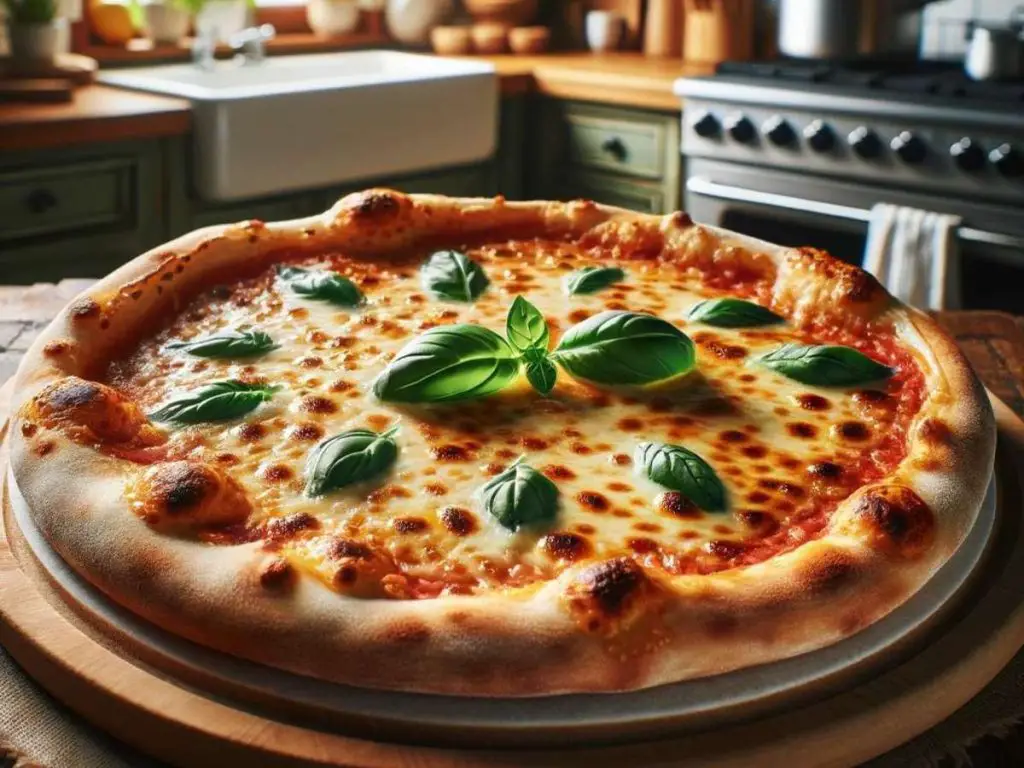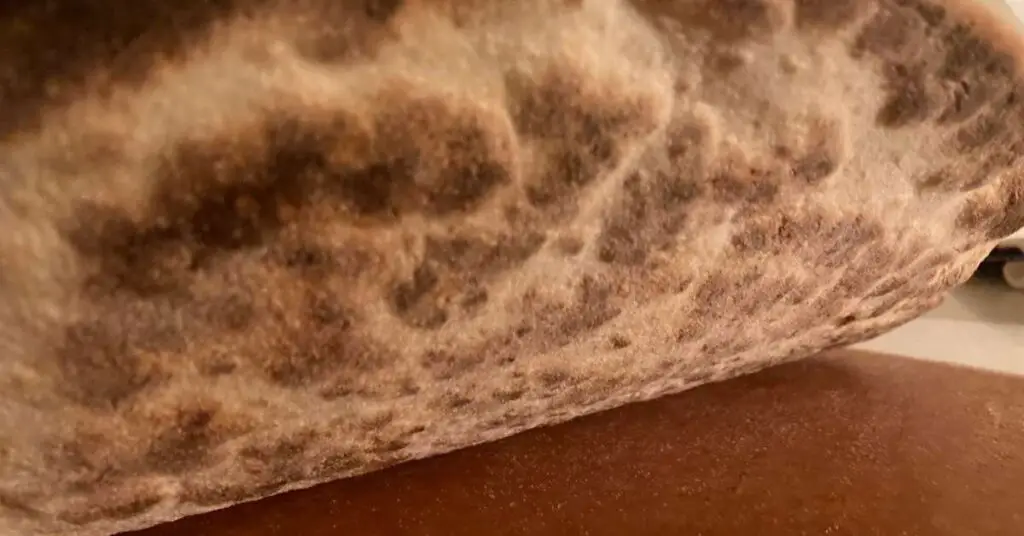Best Temperature To Cook Homemade Pizza In A Regular Home Oven
As you set out to make the perfect pizza at home, one crucial question arises: what is the best temperature to cook homemade pizza? This isn’t just about cranking up your home oven and hoping for the best.
The sweet spot for baking pizza in a regular home oven is generally between 425°F (220°C) and 500°F (260°C). If you’re making a traditional pizza, put the oven on 500°F. If it’s a pan pizza (like Detroit or Sicilian), set the oven to between 425°F and 450°F.
Whether you’re using a pizza stone, pizza steel, or a baking pan, getting the temperature right can make a world of difference when cooking pizzas.
| Cooking Method | Cooking Time | Oven Temperature | Rack Position |
|---|---|---|---|
| Parchment Paper | 10 minutes | 500F (260C) | Bottom |
| Pizza Steel | 8-10 minutes | 500F (260C) | Top |
| Pizza Stone | 10 minutes | 500F (260C) | Middle |
| Pan (Deep Dish) | 20-25 minutes | 425F | Middle |
| Pan (shallow edges) | 10-15 minutes | 475F (260C) | Bottom |

Understanding Optimal Oven Temperatures for Pizza
Making pizza at home is an art, and like any great art, it requires precision, especially when it comes to temperature. Cooking a homemade pizza isn’t just about slapping it into the oven and waiting for the timer to ding. There’s a science behind it.
First, let’s make it clear: Different pizza styles call for slightly different heat. If you’re aiming for that pizzeria-quality, crisp-bottomed, airy-edged goodness, then high heat is your friend. Generally, a temperature to cook homemade pizza should hover around 500°F (260°C), particularly when using a pizza stone or steel.
But what if you’re a fan of deep-dish or a thicker, chewier crust? In that case, a lower temperature, around 425-450°F (220-235°C), can work better. This allows the pizza to cook evenly without burning the top or leaving the base undercooked.
One key aspect to remember is consistency. You can’t just turn your oven to 500°F and throw in the pizza; preheating is vital. Give your oven ample time to reach and stabilize at the desired temperature. This ensures that the moment your pizza hits the oven, it starts cooking at the right heat, especially if you’re using a pizza steel or pizza stone.
Best Pizza Cooking Temperature Reference Chart
For those keen on making pizza with precision and perfection, here’s a handy reference chart. This chart breaks down the optimal temperatures and suggested cooking times for different styles of pizza in a regular home oven. Use this as a guide to elevate your homemade pizza game.
| Pizza Type | Oven Temperature | Cooking Time |
|---|---|---|
| Thin Crust | 475-500°F (246-260°C) | 10-12 minutes |
| Thick Crust/Deep Dish | 425-450°F (220-235°C) | 20-25 minutes |
| Neapolitan-Style | 500°F (260°C) or higher | 8-10 minutes |
| New York-Style | 500°F (260°C) or higher | 12-15 minutes |
| Pan Pizza | 425-450°F (220-235°C) | 20-25 minutes |
Remember, these are guidelines. Different ovens tend to vary quite a bit, so it’s always a good idea to check the pizza a few minutes before the timer goes off. You can always adjust based on your specific oven’s quirks.
The Role of Pizza Stones and Steels

If you’re serious about elevating your home pizza-making game, then let’s talk about pizza stones and steels. These tools play a crucial role in mimicking the heat dynamics of a professional pizza oven.
Using a pizza stone or steel, it’s possible to get that elusive, crispy-bottomed crust that’s often hard to achieve in a standard home oven. These materials absorb high heat and distribute it evenly, simulating the conditions of a commercial pizza oven.
For optimal results, preheat your pizza stone or steel at the maximum temperature your oven can reach – usually around 500°F or higher. This might surprise you, but the high heat is key to getting that perfect crust. Just make sure to preheat for at least 30 minutes, as this will give the stone or steel enough time to get properly hot.
When it’s time to bake, quickly transfer your pizza onto the stone or steel using a pizza peel. This is where things can get a bit tricky. The pizza should land smoothly, without sticking or losing shape. If you’re not confident, use parchment paper on top of (or as a replacement for) your pizza peel – it makes the transfer easier and reduces the chance of burns.
Remember, these high temperatures mean your pizza will cook faster. So, keep an eye on it and check often. You don’t want to burn your pizza after all that effort!
Baking Pan Temperatures for Perfect Crust
Not everyone has a pizza stone or steel, and that’s perfectly fine. You can still make great pizza at home using a regular baking pan. However, the approach changes a bit, especially when it comes to temperature.
For those using a baking pan, aim for a temperature range of 425-450°F (220-235°C). Why slightly lower than a stone or steel? It’s because a pan doesn’t conduct heat as intensely. This temperature allows the pizza dough to cook through evenly, giving you a nice, evenly baked crust without burning the toppings.
But here’s a tip: for an extra crispy bottom, try preheating your baking pan. Yes, it might sound a little risky, but trust me on this. Place the pan in the oven during preheating. When it’s time to bake, carefully transfer your rolled out dough onto the hot pan. This method gives you a head start on achieving that crispy base everyone loves.
Just be sure to check your pizza around the 15-minute mark to see how it’s doing. Different pans and ovens might mean your cooking time could be a little more or less. And don’t forget, the key to a great homemade pizza isn’t just the temperature; it’s also about attention to the small details.
Achieving Perfect Crust Browning and Melted Cheese
Let’s face it, the crust and cheese are what can make or break a homemade pizza. Achieving that perfect balance of a crispy crust and gooey, melty cheese is a craft honed by understanding your oven’s temperature and timing.
For the crust, you’re aiming for a golden-brown finish, not too dark, not too light. This happens best at high temperatures – we’re talking the maximum temperature your home oven can reach. This high heat quickly crisps the outer layer of the dough, creating that perfect texture contrast with the soft inside.
Now, for the cheese. It should be bubbly and slightly golden, not burnt or, worse, under-melted. The trick here? Don’t just throw the cheese on top and hope for the best. Instead, try layering it under some of your toppings. This way, the cheese gets direct heat, but not so much that it burns.
Here’s something else to consider: not all cheeses melt the same. Mozzarella is a classic choice because it melts beautifully. But if you’re feeling adventurous, mix in a little cheddar or gouda for a different flavor profile. Just keep in mind, some cheeses burn faster than others.
In essence, making the perfect pizza is about balancing heat, timing, and your choice of ingredients. Experiment a little, and you might just find your signature style that makes your homemade pizzas not just good but amazing.
Avoiding Undercooking and Maximizing Oven Potential

It’s a common pitfall in home pizza-making: undercooking. You pull out what you think is the perfect pizza, only to find a doughy, uncooked middle. Let’s fix that by understanding how to fully utilize your oven’s heat capabilities.
First and foremost, know your oven. Home ovens can be fickle, and the maximum temperature they can reach varies. Most go up to 500°F, but some can hit 550°F or more. Use an oven thermometer to check the actual temperature, as oven dials can be misleading.
If you’re using a pizza steel or pizza stone, you’ll want to use an infrared thermometer to see the temperature of the surface. You can pick one up at a decent price on Amazon. Ideally, the pizza would go in when the steel or stone reaches the maximum temperature of your oven (or higher).
Now, let’s talk placement. The heat source in ovens is typically at the bottom, so placing your pizza lower in the oven can help ensure a fully cooked crust. However, be careful not to stick it too close to the bottom, or you might end up with a burnt base.
Another tip: if you’re still getting soggy centers, try pre-baking the dough for a few minutes before adding toppings. This gives the crust a head start and can help avoid that dreaded raw middle. This should never be necessary if you’re using a steel or stone, though.
And remember, time the oven carefully. Start checking your pizza a few minutes before the suggested time is up. Every oven is different, and what works in one might need a tweak in another.
In essence, making the perfect homemade pizza is as much about knowing your oven as it is about the recipe you’re following. With a little practice and patience, you’ll get there. Trust me, it’s worth the effort.
Best Temperature To Cook Neapolitan Pizza
When cooking Neapolitan pizza, the temperature is key. Ideally, it should be baked in a wood-fired oven at a very high temperature, typically around 905°F (485°C).
This intense heat allows the pizza to cook rapidly, usually within 60-90 seconds, creating a thin crust that is crispy on the outside and chewy inside. However, most home ovens can’t reach these temperatures.
However, in a standard home oven, you should cook Neapolitan pizza at the highest possible setting, usually between 500°F to 550°F (260°C to 290°C). This high temperature is crucial for achieving the right crust texture. If using a baking stone or a pizza steel, preheat the oven with the stone inside for at least 1-2 hours for the best results.
Final Thoughts
We’ve journeyed through the intricacies of making the ideal homemade pizza, focusing squarely on the pivotal role of temperature. From selecting the best temperature to cook homemade pizza to understanding your specific home oven’s quirks, every detail counts towards achieving that pizzeria-like quality.
Key Takeaways:
- The optimal temperature for most home-made pizzas ranges from 425°F to 500°F.
- Pizza stones and steels can drastically improve crust quality, requiring higher temperatures.
- Baking pan pizzas require slightly lower temperatures and longer cooking times for even cooking.
- Achieving the perfect crust and cheese melt involves balancing high heat, correct placement, and cheese type.
- Understanding your oven’s maximum temperature and cooking characteristics is crucial to avoid undercooking.
- Experimentation and adjusting based on your specific oven and preferences can lead to the perfect pizza recipe.
Remember, making pizza is an adventure, not just a cooking task. Each time you try, you’ll learn something new, and gradually, you’ll find the way that works best for you. So, don’t be afraid to experiment, mix up your toppings, and most importantly, have fun with it. After all, isn’t that what making pizza at home is all about?
Related Posts:
- Pizza Making Ingredients and Tools
- Is A Pizza Steel Worth It? Yes, Here’s Why
- 70% Hydration Pizza Dough Recipe – No More Dry Crust
Related Questions:
How Long Do You Cook Pizza At 450F Degrees?
A pizza cooked at 450F will generally take 15-20 minutes to cook, depending on what kind of pan you’re using and the thickness of the crust.
How Long Do You Bake A Pizza At 400-425F Degrees?
Pizza cooked at lower oven temperatures will take longer to cook, so expect a baking time of 20-25 minutes. For this temperature, I recommend using a high hydration pizza dough to avoid your crust drying out in the oven.
What’s The Best Temperature To Cook Homemade Pizza?
As a rule of thumb, the higher the temperature the better the pizza will be, especially when working with a regular home oven. The exception to this is pan or deep dish pizza, which requires a longer baking time at a lower oven temperature.
Why Is My Pizza Crust Pale And Dry?
At lower temperatures, pizza crust will not brown and caramelize like it would in a high temperature pizza oven. You can remedy this by adding sugar to your pizza dough recipe and using a pizza steel (or stone) to add color to your crust.







